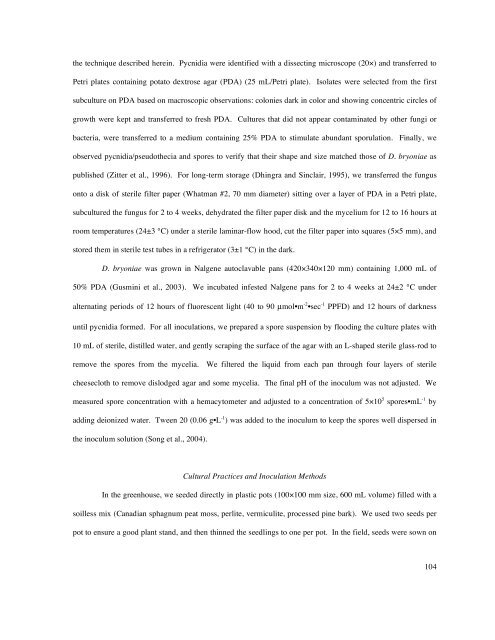Citrullus lanatus (Thunb.) Matsum. & Nakai - Cucurbit Breeding ...
Citrullus lanatus (Thunb.) Matsum. & Nakai - Cucurbit Breeding ...
Citrullus lanatus (Thunb.) Matsum. & Nakai - Cucurbit Breeding ...
Create successful ePaper yourself
Turn your PDF publications into a flip-book with our unique Google optimized e-Paper software.
the technique described herein. Pycnidia were identified with a dissecting microscope (20×) and transferred to<br />
Petri plates containing potato dextrose agar (PDA) (25 mL/Petri plate). Isolates were selected from the first<br />
subculture on PDA based on macroscopic observations: colonies dark in color and showing concentric circles of<br />
growth were kept and transferred to fresh PDA. Cultures that did not appear contaminated by other fungi or<br />
bacteria, were transferred to a medium containing 25% PDA to stimulate abundant sporulation. Finally, we<br />
observed pycnidia/pseudothecia and spores to verify that their shape and size matched those of D. bryoniae as<br />
published (Zitter et al., 1996). For long-term storage (Dhingra and Sinclair, 1995), we transferred the fungus<br />
onto a disk of sterile filter paper (Whatman #2, 70 mm diameter) sitting over a layer of PDA in a Petri plate,<br />
subcultured the fungus for 2 to 4 weeks, dehydrated the filter paper disk and the mycelium for 12 to 16 hours at<br />
room temperatures (24±3 °C) under a sterile laminar-flow hood, cut the filter paper into squares (5×5 mm), and<br />
stored them in sterile test tubes in a refrigerator (3±1 °C) in the dark.<br />
D. bryoniae was grown in Nalgene autoclavable pans (420×340×120 mm) containing 1,000 mL of<br />
50% PDA (Gusmini et al., 2003). We incubated infested Nalgene pans for 2 to 4 weeks at 24±2 °C under<br />
alternating periods of 12 hours of fluorescent light (40 to 90 µmol•m -2 •sec -1 PPFD) and 12 hours of darkness<br />
until pycnidia formed. For all inoculations, we prepared a spore suspension by flooding the culture plates with<br />
10 mL of sterile, distilled water, and gently scraping the surface of the agar with an L-shaped sterile glass-rod to<br />
remove the spores from the mycelia. We filtered the liquid from each pan through four layers of sterile<br />
cheesecloth to remove dislodged agar and some mycelia. The final pH of the inoculum was not adjusted. We<br />
measured spore concentration with a hemacytometer and adjusted to a concentration of 5×10 5 spores•mL -1 by<br />
adding deionized water. Tween 20 (0.06 g•L -1 ) was added to the inoculum to keep the spores well dispersed in<br />
the inoculum solution (Song et al., 2004).<br />
Cultural Practices and Inoculation Methods<br />
In the greenhouse, we seeded directly in plastic pots (100×100 mm size, 600 mL volume) filled with a<br />
soilless mix (Canadian sphagnum peat moss, perlite, vermiculite, processed pine bark). We used two seeds per<br />
pot to ensure a good plant stand, and then thinned the seedlings to one per pot. In the field, seeds were sown on<br />
104
















